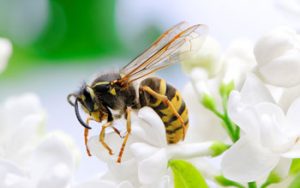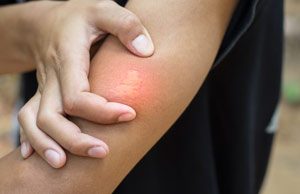 Have you ever noticed that yellow jackets in the Las Vegas area are more aggressive during the fall? You’re not wrong! As summer comes to a close, these wasps notoriously become more hostile as they leave their nests and seek out resources to survive the winter. This is when they typically will invade outdoor barbecues and picnics in the fall. Because yellow jackets can sting more than once, it’s important to know how to protect you and your family from their aggressive behavior throughout the autumn months.
Have you ever noticed that yellow jackets in the Las Vegas area are more aggressive during the fall? You’re not wrong! As summer comes to a close, these wasps notoriously become more hostile as they leave their nests and seek out resources to survive the winter. This is when they typically will invade outdoor barbecues and picnics in the fall. Because yellow jackets can sting more than once, it’s important to know how to protect you and your family from their aggressive behavior throughout the autumn months.
Yellow Jacket Life Cycle
During the spring months, a queen yellow jacket will begin to build a nest before laying her eggs. Once the eggs begin to hatch in the springtime, the wasp population can grow exponentially throughout the summer—colonies have been known to contain up to 5,000 members. When summer winds down, many yellow jackets leave the colony to mate, or are forced out due to limiting resources. This is often when these stinging insects are at their most aggressive as they fight to survive, which is when they frequent more residential areas.
Preventing Wasps in the Fall
Bees and wasps are a normal part of daily life and are valued in our environment. That said, they can also be dangerous, especially in the fall and even more so if someone in your family is allergic to their sting! For that reason, it’s important to know how to keep them away from your outdoor events throughout the fall. Some of the ways you can keep yellow jackets away include:
- Cover all food and garbage with tight-fitting lids.
- Don’t wear bright colors or wear fragrant perfumes.
- Inspect your property for signs of nests in eaves or holes.
- Never walk barefoot through grassy areas.
- Get rid of sources of standing water and place covers on pools.
Professional Yellow Jacket Nest Removal
Because yellow jackets are so aggressive in the fall, it can be hard to stop them from invading your outdoor events. Especially when nests are involved, it’s best to contact a professional with experience controlling yellow jackets and safely removing nests. The team at Rentokil can not only control any current problems you’re having, but also help protect you and your family from future yellow jacket invasions.

 Chances are, most people have been or will be stung by a bee at some point in their life. As painful and surprising as they may be at the time, stings often heal quickly and without complication. Nonetheless, it’s important to take action after being stung! While there are certainly a number of over-the-counter treatments to choose from, you don’t need to stop by the store. Luckily, there are several all-natural remedies that can work to heal a sting right at home.
Chances are, most people have been or will be stung by a bee at some point in their life. As painful and surprising as they may be at the time, stings often heal quickly and without complication. Nonetheless, it’s important to take action after being stung! While there are certainly a number of over-the-counter treatments to choose from, you don’t need to stop by the store. Luckily, there are several all-natural remedies that can work to heal a sting right at home. Ever wonder how insects survive the brutal summer temperatures in Las Vegas? In fact, many types of insects don’t only need warm temperatures to survive—hot weather helps them thrive! Many pests are less active in the winter, and rising temperatures typically signal the beginning of pest season. It goes without saying, then, that Las Vegas summers are ideal for a number of insects who enjoy the temperatures that reach well over 100 degrees on a daily basis. At Western Exterminator of Las Vegas, we want to help our neighbors learn which insects and pests are most common in our extreme desert heat.
Ever wonder how insects survive the brutal summer temperatures in Las Vegas? In fact, many types of insects don’t only need warm temperatures to survive—hot weather helps them thrive! Many pests are less active in the winter, and rising temperatures typically signal the beginning of pest season. It goes without saying, then, that Las Vegas summers are ideal for a number of insects who enjoy the temperatures that reach well over 100 degrees on a daily basis. At Western Exterminator of Las Vegas, we want to help our neighbors learn which insects and pests are most common in our extreme desert heat.